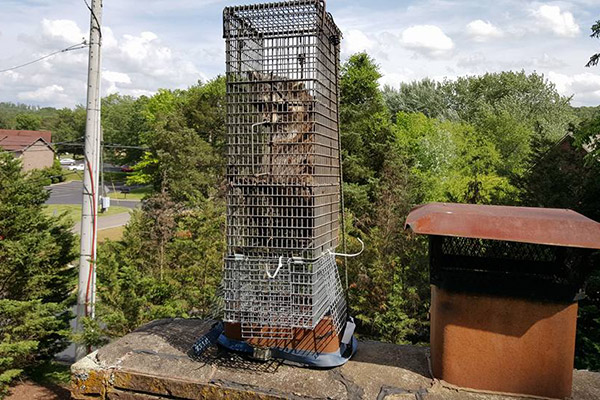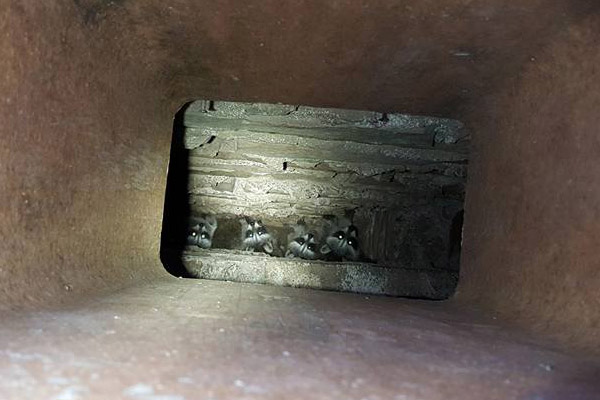- info@animalatticpest.com
- Call - we service 300 locations
How To Get Raccoons Out Of A Chimney


One of the most commonly found animals in chimneys is the raccoon. In most cases, mother raccoons will enter a chimney to give birth to her babies and then raise the babies. Male raccoons may also take up residence since chimneys are similar to hollow trees, a favorite nesting spot. Since raccoons are excellent climbers, they can easily get in and out without an issue, provided that you don’t have a chimney cap in place.
Use A Professional Trap
The best method of getting raccoons out of your chimney is to hire a professional to take care of it for you. They will have a special trapping system that easily mounts right on top of your chimney flu. Pros may use this with or without a pole and trap system that makes the adult raccoon move upwards until they entire the trap. If you insist on trying it yourself, you may see results by placing a trap at the top of the chimney. Just be sure to check it very regularly so the raccoon is not stuck there exposed to the elements, particularly during the day when overheating and dehydration are real concerns.
Removing The Young
When the raccoons in your chimney are in fact a mother and her babies, you will have to take the young out by hand. Never do this with the mother still in the chimney as she can attack. Instead, wait until the mother is out and then get the babies out. In most cases, you will need to use a mirror to see the see the young so you can grab them with your hands or a safe snare.
NEVER Use Fire
Some people are tempted to turn on their fireplace to get the raccoons out of the chimney. They figure that since the animal got in by itself, it can get out as well. In reality, you are likely to kill the animal, particularly any babies present, in a very inhumane manner. Also, remember that if you start a fire, you would need to open the damper and may end up with a raccoon in your living room. The biggest issue, however, is the fact that this is very inhumane.
Prevent Reentry
There is no point to getting the raccoons out of your attic if you don’t make any changes. The same raccoons will just come back or other animals may take their place. At the very least, invest in a chimney cap to prevent animals from getting in on purpose or falling in.

More Advice on How to Get Rid of Raccoons in the Chimney: There are a few reasons why you’ll end up with a raccoon in your chimney. For a start, it looks a little bit like a hollow tree, which is where the animal would naturally live in the great wild outdoors. Secondly, it’s safe, warm, and dry.
Normally, if you have a raccoon stuck in yours, it’ll be a female raccoon, looking for somewhere to have her babies, and then take care of them until they are old enough to take care of themselves. Being animals very well adapted to climbing trees, getting in and out of your chimney is not a hard task, and once they’re in there, they’re famously difficult to get rid of.
If you want to learn how to get raccoons out of a chimney, I have one very good piece of advice for you - call in the help of a professional wild animal expert. This is not going to be an easy task.
A professional will have access to a very specific kind of trap which forces, or waits for, the raccoon to try and climb out before capturing them, allowing the mother (and hopefully the babies) to be relocated somewhere else - somewhere they won’t be a burden for you.
The trick is to get the mother out, and then get the babies out. If you try and do it the other way around, you are bound to get attacked. A mother raccoon is fiercely defensive of her babies, and will protect them at any cost. Another way to try and deal with the problem is to wait for the mother to first go out on the hunt for food before snaring the pups, and then trapping the mother later on. Either way, it’s not something you’re easily going to achieve yourself, especially if this is your first time.
There are a few things you definitely don’t do when you are learning how to get raccoons out of the chimney. Lighting a fire is a very bad idea. You’ll need to open the dampener and when you do, the babies could run out, creating havoc in your house. Also, are you really trying to burn these creatures to death? Because that is the other thing that could happen, and in most states, that’s actually illegal. Plus it’ll smell really bad, and that stench will fill your house quickly, just like bad smells do.
Once the raccoon and her babies (if any) are safely capture and removed from the chimney, you can then take preventative measures to make sure the problem doesn’t come back. A steel cap can be added to chimney tops to prevent the critters from climbing down, and is an easy fix for something that could turn into a very bad problem.
